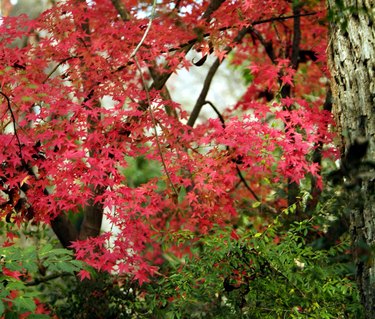
Home gardeners and professional landscapers alike love Japanese maples (Acer palmatum) for their delicate foliage and brilliant fall colors. These graceful trees make attractive specimen plants, especially the smaller cultivars. Dwarf Japanese maple trees are usually classified as those that reach a maximum height of only around 4 feet by the time they are 10 years old. Like most trees, they have relatively shallow roots.
Shallow Japanese Maple Roots
Video of the Day
Maple trees (Acer spp.) have shallow roots, and dwarf Japanese maples are no exception. The feeder roots in particular are very close to the surface of the soil. This is actually true of most trees. Unlike many perennials, most trees do not have deep tap roots. Instead, they have shallow roots that extend down to about 3 feet below the surface of the soil at the deepest. Most of the smaller feeder roots are within the top few inches of the soil.
Video of the Day
Because immature roots probably aren't able to take up nutrients, fertilizing young Japanese maples is just a waste of resources. Even older specimens need little if any additional fertilizer as long as they're situated in soil with plenty of organic material.
These shallow roots can extend far past the tree's canopy. In fact, a tree's roots can grow three times the spread of the branches within three years of being planted in a landscape.
Beware of Sensitive Roots
Because the roots of maples are so close to the surface, care must be taken when working with garden tools around these trees. Roots can be damaged by disruptions in the soil, such as digging to install a sprinkler system, or even using a lawn mower around the tree. A good way to protect the roots of your dwarf Japanese maple trees -- as well as conserve moisture in the soil -- is to put a 4-inch layer of mulch around the tree and over any exposed roots. Extend the layer to the edge of the tree's canopy.
Known For Their Interesting Foliage
Healthy roots mean healthy foliage, and this is especially important when it comes to Japanese maples, which are prized for their colorful leaves. Dwarf Japanese maples will show their best colors -- which range from purple to gold, orange, red, burgundy and brilliant lime green -- when the tree is grown in rich, well-draining soil that is kept evenly moist. Water should never be left to collect around the roots of the tree, as this can lead to root rot, a fungal disease that destroys the roots and may eventually kill the tree. For this reason, never plant a Japanese maple in a depression where water tends to collect or in wet, boggy soil.
Relatively Hardy Dwarf Maples
Despite their delicate appearance, dwarf Japanese maples are relatively hardy plants as long as they are cared for properly. Most are slow-growing and are hardy in U.S. Department of Agriculture plant hardiness zones 5 through 8. Too much sun, wind or drought -- keep them watered during dry spells -- can cause the leaves to turn brown; so, a partially shaded location protected from the wind is best.